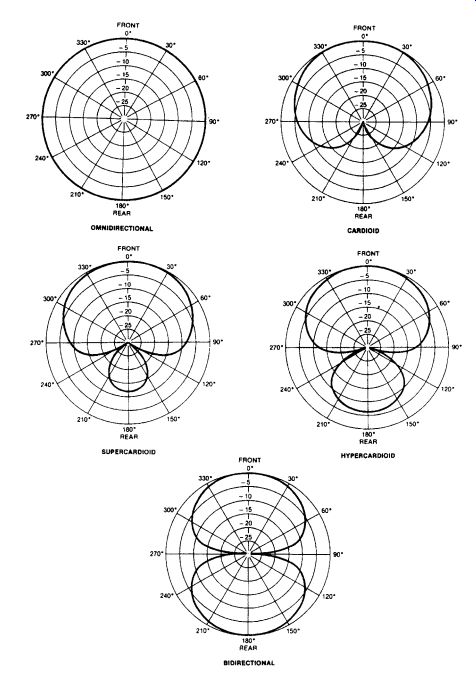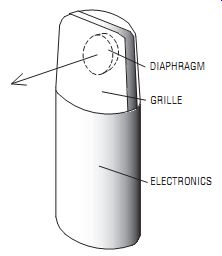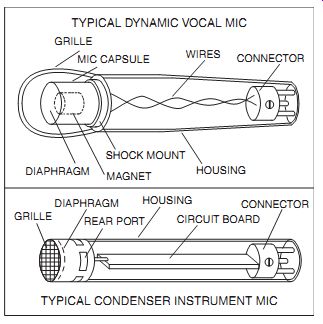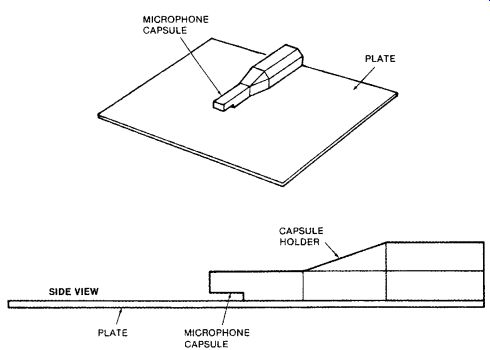Classical music ensembles are recorded with stereo microphone techniques. You place two or three mics in an arrangement several feet in front of the ensemble to pick up the group and the hall reverberation as a whole.
Before you can understand how stereo microphone arrays work, you need to understand microphone polar patterns. This section explains them, as well as other specifications that help you choose mics and accessories for stereo recording.
Polar Patterns
Microphones differ in the way they respond to sounds coming from different directions. Some mics pick up sound equally from all directions. Other mics emphasize sound from the front, but have reduced pickup of sounds coming from the sides and rear. In other words, the sensitivity of the mic varies depending on the angle of the sound source.
For example, a source in front of a mic (0° on axis) might produce a signal level from the mic that we'll call 0dB. That same source at the side of the mic (90° off axis) might produce a signal at +/-6dB. The same source at the rear of the mic (180° off axis) might produce a signal at +/-20dB.
A mic with this characteristic has a cardioid polar pattern. If you talk into a cardioid microphone from all sides while listening to its output, your reproduced voice will be loudest when you talk into the front of the micro phone and softest when you talk into the rear.
If we graph or plot this varying sensitivity versus angle around the mic, we get a polar pattern for the microphone. Sensitivity in dB is plotted versus the angle of sound incidence in degrees. Often, several plots are made at various frequencies.
The three major polar patterns are omnidirectional, unidirectional, and bidirectional (FIG. 1):
1. An omnidirectional (omni) mic is equally sensitive to sounds arriving from all directions.
2. A unidirectional microphone is most sensitive to sounds arriving from one direction-in front of the microphone-and rejects sounds entering the sides or rear of the microphone.
3. A bidirectional microphone is most sensitive to sounds arriving from two directions-in front of and behind the microphone-but rejects sounds entering the sides. Another name for "bidirectional" is "figure-eight."
Three types of unidirectional patterns are cardioid, supercardioid, and hypercardioid (FIG. 1):

FIG. 1 Various polar patterns. Sensitivity is plotted versus angle of
sound incidence.
1. The cardioid mic is sensitive to sounds arriving from a broad angle in front of the microphone. It is about 6dB less sensitive at the sides and about 15-25dB less sensitive at the rear.
2. The supercardioid pattern is about 9dB down at the sides and has two nulls-points of least pickup-at 125° off axis. "Off axis" means "away from the front."
3. The hypercardioid pattern is 12dB down at the sides and has two nulls of least pickup at 110° either side off axis.
An omnidirectional boundary microphone (a surface-mounted microphone, explained later) has a half-omni, or hemispherical, polar pattern. A unidirectional boundary microphone has a half-supercardioid or half-cardioid polar pattern. The boundary mounting increases the directionality of the microphone and reduces pickup of room acoustics.
Some condenser mics come with switchable polar patterns.
Note that a polar plot is not a geographical map of the "reach" of a microphone; a microphone does not suddenly become dead outside its polar pattern. There is no "outside." The graph merely plots sensitivity at one frequency as distance from the origin; it is not the spatial spread of the pattern.
Advantages of Each Pattern
Omnidirectional microphones have several characteristics that make them especially useful for certain applications. Use omni mics when you need:
• all-around pickup,
• extra pickup of room reverberation,
• low handling noise and low wind noise,
• extended low-frequency response in omni condenser mics,
• freedom from proximity effect (up-close bass boost).
Use directional microphones when you need:
• rejection of room acoustics and background noise,
• coincident or near-coincident stereo (explained in the next section).
Off-Axis Coloration
In a quality microphone, the polar pattern is about the same at all frequencies between about 100Hz and 10 kHz. If not you'll hear off-axis coloration:
the mic will sound tonally different on and off axis. For example, the treble might be strong on axis and weak off axis.
Transducer Type
We've seen that microphones differ in their polar patterns. They also differ in the way they convert sound into electricity. The three operating principles of recording microphones are condenser, moving coil, and ribbon.
Of the three types, the condenser microphone generally has the widest, smoothest frequency response, and the highest sensitivity. It tends to have a natural, detailed sound, and it produces a strong signal that over rides mic-preamp noise. So it is the first choice for miking a classical music ensemble.
The condenser mic requires a power supply to operate, such as a battery or phantom power. Phantom power is provided by an external phantom-power supply, a mixer, or a mic preamp.
Ribbon mics have a smooth response, and most have a figure-eight polar pattern-making them suitable for the Blumlein stereo mic technique covered in Section B.
Sensitivity
Sensitivity is another specification to consider. It is a measure of the efficiency of a microphone. Avery sensitive microphone produces a relatively high output voltage from a sound source of a given loudness.
Microphone sensitivity is usually stated in millivolts/Pa, where 1Pa = 1 pascal +/- 94dB SPL. The following list gives typical sensitivity specs for the three microphone types:
Condenser: 10mV/Pa (high sensitivity)
Moving coil: 2mV/Pa (medium sensitivity)
Ribbon or small moving coil: 1mV/Pa (low sensitivity)
A low-sensitivity mic requires more mixer gain to achieve a good recording level than a high-sensitivity mic, and more gain usually results in more noise.
If you record quiet, distant instruments, such as a classical guitar or those of a chamber music ensemble, you'll hear more mixer noise with a low sensitivity mic than with a high-sensitivity mic, all else being equal. Because stereo miking is usually done at a distance, high sensitivity is an asset.
Self-noise
Self-noise is the electrical noise (hiss) a microphone produces. This spec is usually A-weighted-that is, the noise was measured through a filter that makes the measurement correlate more closely with the annoyance value. The filter rolls off low and high frequencies to simulate the frequency response of the human ear. An A-weighted self-noise spec of 14dB SPL or less is excellent (quiet); a spec around 20dB SPL is very good, and a spec around 25dB SPL is verging on too noisy for distant miking of quiet music.
Microphone Types
Another specification is the type of microphone: the generic classification.
Some types of microphones for stereo miking are free field, boundary, and stereo.
Free-Field Microphone

FIG. 2 A side-addressed, large-diaphragm microphone.

FIG. 3 An end-addressed, small-diaphragm microphone.
Most microphones are of this type. They are meant to be used in a free field-that is, away from reflective surfaces. Two types of free-field mics are the side-addressed large-diaphragm type (FIG. 2) and the end addressed small-diaphragm type (FIG. 3). Both types are used to mike orchestras. In general the large-diaphragm type has lower noise, while the small-diaphragm type has less off-axis coloration (the tone quality is almost the same on and off axis).

FIG. 4 Crown PZM construction (Crown International).
Boundary Microphone
A boundary microphone is designed to be used on such surfaces as a floor, wall, table, piano lid, baffle, or panel. One example of a boundary micro phone is the Crown Pressure Zone Microphone (PZM) shown in FIG. 4. It includes a miniature omni condenser capsule mounted facedown next to a sound-reflecting plate or boundary. Because of this construction, the microphone diaphragm receives direct and reflected sounds in-phase at all frequencies, avoiding phase interference between them. The claimed benefits are a wide, smooth frequency response free of phase cancellations, excellent clarity and "reach," a hemispherical polar pattern, and uniform frequency response anywhere around the microphone. Because of this last characteristic, hall reverberation is picked up without tonal coloration.
If an omnidirectional boundary mic is placed on a panel, it becomes directional. Thus, boundary mics on angled panels can be used for stereo arrays. Boundary microphones are also available with a unidirectional polar pattern. They have the benefits of both boundary mounting and the unidirectional pattern. Such microphones are well suited for stage-floor pickup of drama, musicals, or small musical ensembles.
Stereo Microphone
A stereo microphone combines two mic capsules in a single housing for convenient stereo recording. Simply place the microphone about 10-15 feet in front of a band, choir, or orchestra, and you'll get a stereo recording with little fuss. In general, a stereo microphone is easier to set up than two separate microphones, but it's more expensive.
Several models of stereo microphones are listed in Section 12 and one is shown in FIG. 5.
Most stereo microphones are made with coincident microphone capsules; they occupy nearly the same point in space. Since there is no horizontal spacing between the capsules, there also is no delay or phase shift between their signals. If you combine the two stereo mic channels to mono, there is no phase interference that can degrade the frequency response. Thus, the coincident-pair stereo microphone is mono-compatible: the frequency response is the same in mono as in stereo.
Stereo microphones are available in many configurations, such as XY, MS, Blumlein, ORTF, OSS, SoundField, and SASS (all described in Appendices B and C). The MS (mid-side) stereo microphone and SoundField microphone let you remote-control the stereo spread and vary the stereo spread after recording.

FIG. 5 A stereo microphone.
Microphone Accessories
Various accessories used with microphones enhance their convenience, aid in placement, or reduce vibration pickup.
Stands and Booms
The top of a mic stand has a standard 5/8 inch-27 thread (3/8 inch outside the US), which screws into a microphone stand adapter. Camera stores have photographic stands, which are collapsible and lightweight-ideal for recording on location. The thread is usually 1/4 inch-20, which requires an adapter to fit a 5/8 inch-27 (or 3/8 inch) thread in a mic stand adapter.
Some mic stands have telescoping sections for extra height, and some have collapsible tripod stands for more stability and less weight.
You can use a mic boom as an extension to raise a microphone farther off the floor-in order to stereo mike an orchestra, for example.
Stereo Microphone Adapter
A stereo microphone adapter (stereo bar or stereo rail) mounts two micro phones on a single stand for convenient stereo miking. Several models of these are listed in Section 12, and one is shown in FIG. 6. In most models, the microphone spacing and angling are adjustable.

FIG. 6 A stereo microphone adapter.
Shock Mount
When mounted on a mic stand, this device holds a microphone in a resilient suspension to isolate the microphone from mechanical vibrations, such as stand and floor thumps. The shock mount acts as a spring that resonates at a sub-audible frequency with the mass of the microphone. This mass-spring system attenuates mechanical vibrations above its resonance frequency.
Many microphones have an internal shock mount that isolates the microphone capsule from its housing; this reduces handling noise as well as stand thumps.
With a good grasp of microphone specs and accessories, we're ready to discuss stereo mic techniques.